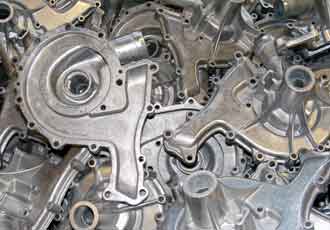How are Aluminium die cast products produced?

Used for a wide variety of applications, aluminium die casting is seen in items such as door knobs and in an entire engine block. Whilst many people have heard of the term few are aware of the processes involved. Die casting was initially invented in 1838 for the printing industry and with the growth of consumer products some 20 years later it became part of the manufacturing process for many other goods. Starting off with lead and tin, the alloys used were then surpassed by aluminium and zinc.
High-pressure die casting consists of four different stages, die preparation, filling, ejection and shakeout.
Firstly the mould cavity of the die is cleaned and sprayed with lubricant, aiding in the removal of the casting whilst also maintaining the temperature of the die. Once the two die halves are closed and clamped together, high pressure molten aluminium is transferred from the furnace into a chamber and injected into the die.
This fills the mould cavity, which is pressure controlled (typically from 1,000-20,000psi) cooling rapidly until the casting becomes solid. The injection time is usually less than 0.1 seconds to inhibit any one part of the alloy solidifying, although this injection time can vary dependent on the alloy used and the castings wall thickness - the larger the wall thickness, the longer the injection time.
Once the molten aluminium fills the cavity and cools, the finished shape of the casting is formed. The die halves can now be opened and an ejection mechanism pushes the casting out of its mould. The force of the mechanism must be strong enough to eject the part as it shrinks whilst cooling and adheres to the die. Once ejected any excess material is manually trimmed from the casting, and this unrequired material can then be reused.
The advantages of using aluminium in die casting are that it has a very good stiffness, superior corrosion resistance when compared with other alloys, is strong yet lightweight and has a high electrical conductivity. It also possesses excellent finishing characteristics and is fully recyclable.
UK based Mark Aluminium Die Casting (MADC) has been manufacturing cast aluminium products for over 30 years. As part of the Mark group it is established in the manufacturing of water pumps for a wide range of automotive manufactures, including such established names as Jaguar, Aston Martin and Land Rover. MADC also specialises in the production of heat sinks for LED lights and processors and impact resistant electrical enclosures.
David Lewis Plant Manager of both Mark Aluminium Die Casting and sister company Mark Water Pumps commented: “Having our own on-site foundry is a big advantage in being able to manufacture various types of high pressure die cast products. This enables us to be flexible in producing practically any type of small to large volume die cast product quickly and efficiently. We strongly believe in manufacturing a high standard of finished product but also understand that it needs to be cost effective for our customers. To this end we are able to offer a variety of dies and moulds to satisfy the largest range of price, precision and volume demands.”
Similar articles
More from Mark Aluminium Die Casting (MADC)
- The future metal requirements of EVs and hybrids 3rd September 2019
- Custom die cast Aluminium casings 2nd October 2017
- Aluminium Die Casting company makes light of a difficult product 13th September 2017
- How are Aluminium die cast products produced? 31st May 2017












Write a comment
No comments